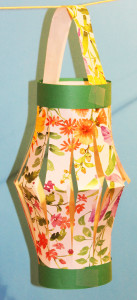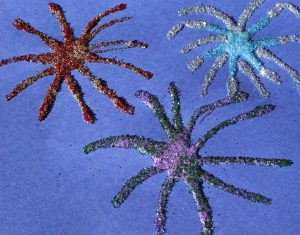
easy craft for kids
Our Sunday School program finds a way to celebrate the holidays of most major religions. Sometimes, we celebrate them along with the rest of the world. Sometimes, we celebrate them at the “wrong” time as part of a theme. The kids don’t care. Like the other holidays we celebrate, Diwali is a great opportunity for them to connect with their peers from around the globe who commemorate special times, just as they do, but in a different way. And they’re always happy to hear about other kids who have to help clean the house before friends and relatives come over.
Celebrated in different ways around the world, Diwali, the Hindu festival of light, is an easy holiday for making connections. First and foremost, Diwali honors the triumph of good over evil. The oil lamps, the fireworks, and the lanterns all serve as reminders that the light will always be victorious over the darkness. Younger kids can talk about how they bring light and goodness into the world. Older kids can also be reminded of the ways in which they might use lights at certain holidays – candles in Halloween Jack-O’-Lanterns, lights around an Advent wreath, and vigil candles in Christmas Eve services.
During Diwali, special attention is paid to Lakshmi, the goddess of wealth and prosperity who brings good luck, and to Krishna, who defeated the evil Narakasura. Some Hindus offer food to the deities. Houses are cleaned and decorated. Special clothes can be worn. Pre-dawn baths may be taken. Mythical tales are revisited. And everyone enjoys sweet treats. Each ritual has counterparts that our kids can both recognize and identify with.
Diwali also offers great craft ideas. In some Hindu communities, rangolis are made. These beautiful designs can be composed of sand, rice, flour, or flower petals. Many times, bright colors are used, but white designs are also seen. Our youngest kids (ages 4-8 years) use smaller, less detailed outlines and fill them in with colored sand to complete individual rangolis. Our older kids (ages 8-13) make large, group rangolis with a more detailed design that is filled in with flower petals. An internet search for rangoli designs provides plenty of age-appropriate patterns.
In previous years, our kids have made various Diwali lights. Even the youngest kids can make images of fireworks with glue and glitter. Easy paper lanterns using a single piece of paper, scissors, and a bit of tape can be made by kids of all ages. And older kids can make real oil lamps using Mason jars or glass bottles with screw caps. Numerous Diwali books offering varying levels of detail are also available. They are outlined below.
Diwali is not a Christian holiday, and we do not advocate twisting it into one. Hindus possess a different vision of the divine, their folkloric tradition is largely unfamiliar to American kids, and Hindu festivities are often as diverse as the people who celebrate them. Despite all that, Diwali is a great example of how kids from around the world use ritual to forge a deeper connection with the sacred and with each another. Understanding that, appreciating that, and honoring that should be a primary goal of all progressive churches. After all, isn’t a blessed life always about finding ways to stay on the path of love, peace, goodness, and light?
Diwali Books to Consider
Lighting a Lamp: A Diwali Story by Jonny Zucker and Jan Barger (Barron’s, 2004). Great for our younger groups – preschoolers and lower elementary. Colorful illustrations. Part of the Festival Time series.
Diwali by Trudy Strain Trueit (Scholastic, 2007). Also good for preschoolers and kids in the lower elementary grades. Photographs of real people. Part of the Rookie Read-About-Holidays series.
Diwali by Kate Torpie (Crabtree, 2008). Colorful and factual with straight-forward information about typical Diwali celebrations. We use this book with both lower and upper elementary kids. Photographs of real people. Part of the Celebrations in My World series.
Celebrate Diwali with Sweets, Lights, and Fireworks by Debra Heiligman (National Geographic, 2008). Factual with information and photographs about Diwali celebrations from around the world. A bit long, but we can use it with our upper elementary kids.
The Story of Divaali retold by Jatinder Verma and illustrated by Nilesh Mistry (Barefoot Boos, 2002). One version of the classic Ramayana tale, with Prince Rama, Princess Sita, Lakshmana and Hanuman. Beautiful illustrations, but way too long for us to use in a Sunday School class.
